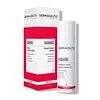What's inside
What's inside
 Key Ingredients
Key Ingredients

 Benefits
Benefits

 Concerns
Concerns

 Ingredients Side-by-side
Ingredients Side-by-side

Water
Skin ConditioningParaffinum Liquidum
EmollientCetearyl Alcohol
EmollientArbutin
AntioxidantKojic Acid
AntioxidantNiacinamide
SmoothingMandelic Acid
AntimicrobialSalicylic Acid
MaskingGlycyrrhetinic Acid
Skin ConditioningTocopherol
AntioxidantCeteareth-12
EmulsifyingLecithin
EmollientSodium Cetearyl Sulfate
CleansingSodium Lauryl Sulfate
CleansingEthylhexylglycerin
Skin ConditioningBenzyl Alcohol
PerfumingPotassium Sorbate
PreservativePhenoxyethanol
PreservativeDimethicone
EmollientDisodium Phosphate
BufferingDipotassium Phosphate
BufferingSodium Hydroxide
BufferingWater, Paraffinum Liquidum, Cetearyl Alcohol, Arbutin, Kojic Acid, Niacinamide, Mandelic Acid, Salicylic Acid, Glycyrrhetinic Acid, Tocopherol, Ceteareth-12, Lecithin, Sodium Cetearyl Sulfate, Sodium Lauryl Sulfate, Ethylhexylglycerin, Benzyl Alcohol, Potassium Sorbate, Phenoxyethanol, Dimethicone, Disodium Phosphate, Dipotassium Phosphate, Sodium Hydroxide
Water
Skin ConditioningPropylene Glycol
HumectantLecithin
EmollientAlcohol
AntimicrobialPolymethyl Methacrylate
PEG-40 Hydrogenated Castor Oil
Emulsifying4-Butylresorcinol
AntioxidantAscorbyl Glucoside
AntioxidantRetinol
Skin ConditioningAzelaic Acid
BufferingNiacin
SmoothingUndecylenoyl Phenylalanine
Skin ConditioningGlycyrrhetinic Acid
Skin ConditioningMorus Alba Root Extract
BleachingDiacetyl Boldine
Skin ConditioningPEG/PPG-20/6 Dimethicone
EmulsifyingSodium Cholate
Skin ConditioningPolysorbate 20
EmulsifyingXanthan Gum
EmulsifyingCarbomer
Emulsion StabilisingTriethanolamine
BufferingTocopheryl Acetate
AntioxidantBHT
AntioxidantSodium Hydroxide
BufferingCaprylic/Capric Triglyceride
MaskingSodium Chloride
MaskingHydroxypropyl Cyclodextrin
MaskingBHA
AntioxidantPentaerythrityl Tetra-Di-T-Butyl Hydroxyhydrocinnamate
AntioxidantTriisopropanolamine
BufferingHydrochloric Acid
BufferingPhenoxyethanol
PreservativeEthylhexylglycerin
Skin ConditioningParfum
MaskingCitronellyl Methylcrotonate
MaskingCitral
PerfumingCoumarin
PerfumingEugenol
PerfumingLimonene
PerfumingIsoeugenol
PerfumingWater, Propylene Glycol, Lecithin, Alcohol, Polymethyl Methacrylate, PEG-40 Hydrogenated Castor Oil, 4-Butylresorcinol, Ascorbyl Glucoside, Retinol, Azelaic Acid, Niacin, Undecylenoyl Phenylalanine, Glycyrrhetinic Acid, Morus Alba Root Extract, Diacetyl Boldine, PEG/PPG-20/6 Dimethicone, Sodium Cholate, Polysorbate 20, Xanthan Gum, Carbomer, Triethanolamine, Tocopheryl Acetate, BHT, Sodium Hydroxide, Caprylic/Capric Triglyceride, Sodium Chloride, Hydroxypropyl Cyclodextrin, BHA, Pentaerythrityl Tetra-Di-T-Butyl Hydroxyhydrocinnamate, Triisopropanolamine, Hydrochloric Acid, Phenoxyethanol, Ethylhexylglycerin, Parfum, Citronellyl Methylcrotonate, Citral, Coumarin, Eugenol, Limonene, Isoeugenol
Ingredients Explained
These ingredients are found in both products.
Ingredients higher up in an ingredient list are typically present in a larger amount.
Ethylhexylglycerin (we can't pronounce this either) is commonly used as a preservative and skin softener. It is derived from glyceryl.
You might see Ethylhexylglycerin often paired with other preservatives such as phenoxyethanol. Ethylhexylglycerin has been found to increase the effectiveness of these other preservatives.
Glycyrrhetinic acid is a compound found in licorice. It has skin conditioning, skin soothing, antibacterial, and antioxidant properties.
Not only is this a great ingredient for soothing inflammation, studies show this compound is effective at protecting skin against UV-B induced damage.
Fun fact: This ingredient is also used to mask the bitter taste of medicine.
Learn more about Glycyrrhetinic AcidLecithin is a term for a group of substances found in the cell membranes of plants, animals, and humans. They are made up of mixture of phospholipids.
This ingredient has emollient and emulsifying properties.
As an emollient, lecithen helps soften the skin and creates a barrier to keep moisture in.
As an emulsifier, it also helps prevent water and oil ingredients from separating. Lecithin can also help ingredients be better absorbed by the skin.
This is because the phospholipids in lecithin produce liposomes. Liposomes help other ingredients get through the skin barrier.
Depending on the source of this ingredient, lecithin may not be fungal acne safe. This is because some sources of lecithin come from soybean oil, which may feed the malassezia yeast that feeds fungal acne.
We recommend reaching out to the brand you are purchasing from to inquire about the source of their lecithin.
Some other names for this ingredient include soy lecithin and deoiled soy lecithin.
Learn more about LecithinPhenoxyethanol is a preservative that has germicide, antimicrobial, and aromatic properties. Studies show that phenoxyethanol can prevent microbial growth. By itself, it has a scent that is similar to that of a rose.
It's often used in formulations along with Caprylyl Glycol to preserve the shelf life of products.
Sodium Hydroxide is also known as lye or caustic soda. It is used to adjust the pH of products; many ingredients require a specific pH to be effective.
In small amounts, sodium hydroxide is considered safe to use. However, large amounts may cause chemical burns due to its high alkaline.
Your skin has a natural pH and acid mantle. This acid mantle helps prevent harmful bacteria from breaking through. The acid mantle also helps keep your skin hydrated.
"Alkaline" refers to a high pH level. A low pH level would be considered acidic.
Learn more about Sodium HydroxideWater. It's the most common cosmetic ingredient of all. You'll usually see it at the top of ingredient lists, meaning that it makes up the largest part of the product.
So why is it so popular? Water most often acts as a solvent - this means that it helps dissolve other ingredients into the formulation.
You'll also recognize water as that liquid we all need to stay alive. If you see this, drink a glass of water. Stay hydrated!
Learn more about Water